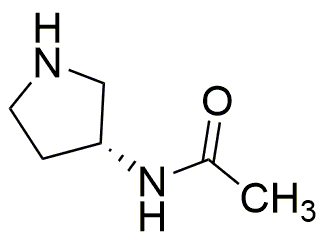(3R)-(+)-3-Acetamidopyrrolidine is widely utilized in research focused on
- Pharmaceutical Development: This compound serves as an important intermediate in the synthesis of various pharmaceuticals, particularly in the development of analgesics and anti-inflammatory drugs.
- Neuroscience Research: It is used in studies related to neurotransmitter modulation, helping researchers understand its potential effects on cognitive functions and mood disorders.
- Analytical Chemistry: The compound is employed in the formulation of analytical standards for chromatographic techniques, aiding in the accurate quantification of related substances in complex mixtures.
- Biochemical Studies: It acts as a building block in the synthesis of biologically active molecules, facilitating the exploration of new therapeutic agents in drug discovery.
- Material Science: The compound finds applications in the development of novel polymers and materials, enhancing properties such as flexibility and thermal stability.
General Information
Properties
Safety and Regulations
Applications
(3R)-(+)-3-Acetamidopyrrolidine is widely utilized in research focused on
- Pharmaceutical Development: This compound serves as an important intermediate in the synthesis of various pharmaceuticals, particularly in the development of analgesics and anti-inflammatory drugs.
- Neuroscience Research: It is used in studies related to neurotransmitter modulation, helping researchers understand its potential effects on cognitive functions and mood disorders.
- Analytical Chemistry: The compound is employed in the formulation of analytical standards for chromatographic techniques, aiding in the accurate quantification of related substances in complex mixtures.
- Biochemical Studies: It acts as a building block in the synthesis of biologically active molecules, facilitating the exploration of new therapeutic agents in drug discovery.
- Material Science: The compound finds applications in the development of novel polymers and materials, enhancing properties such as flexibility and thermal stability.
Documents
Safety Data Sheets (SDS)
The SDS provides comprehensive safety information on handling, storage, and disposal of the product.
Product Specification (PS)
The PS provides a comprehensive breakdown of the product’s properties, including chemical composition, physical state, purity, and storage requirements. It also details acceptable quality ranges and the product's intended applications.
Certificates of Analysis (COA)
Search for Certificates of Analysis (COA) by entering the products Lot Number. Lot and Batch Numbers can be found on a product’s label following the words ‘Lot’ or ‘Batch’.
*Catalog Number
*Lot Number
Certificates Of Origin (COO)
This COO confirms the country where the product was manufactured, and also details the materials and components used in it and whether it is derived from natural, synthetic, or other specific sources. This certificate may be required for customs, trade, and regulatory compliance.
*Catalog Number
*Lot Number
Safety Data Sheets (SDS)
The SDS provides comprehensive safety information on handling, storage, and disposal of the product.
DownloadProduct Specification (PS)
The PS provides a comprehensive breakdown of the product’s properties, including chemical composition, physical state, purity, and storage requirements. It also details acceptable quality ranges and the product's intended applications.
DownloadCertificates of Analysis (COA)
Search for Certificates of Analysis (COA) by entering the products Lot Number. Lot and Batch Numbers can be found on a product’s label following the words ‘Lot’ or ‘Batch’.
*Catalog Number
*Lot Number
Certificates Of Origin (COO)
This COO confirms the country where the product was manufactured, and also details the materials and components used in it and whether it is derived from natural, synthetic, or other specific sources. This certificate may be required for customs, trade, and regulatory compliance.


